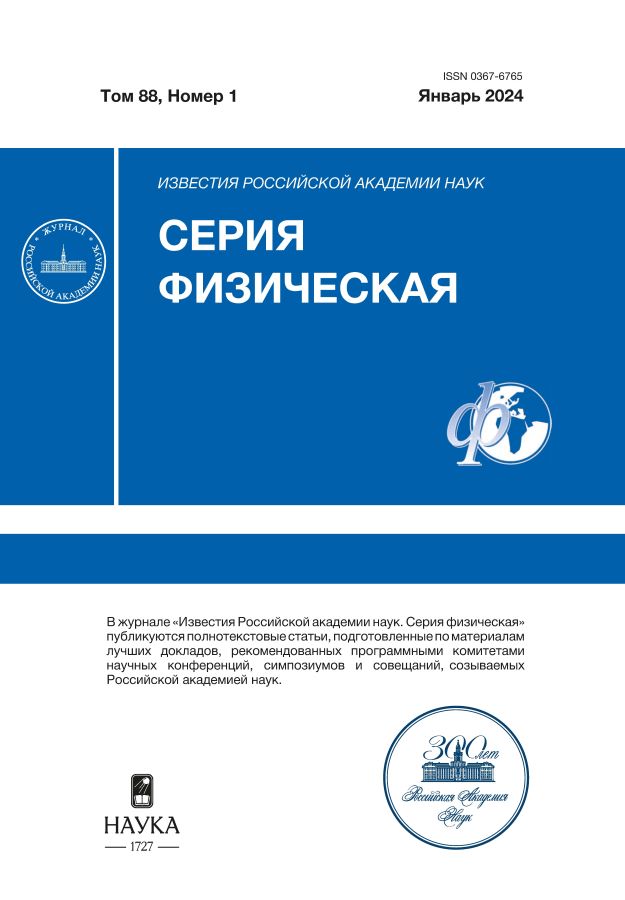Characteristics of a distributed location system with an ultra-wideband probing signal
- Authors: Kulagin V.V.1, Valuev V.V.2,3, Kornienko V.N.4, Cherepenin V.A.4
-
Affiliations:
- Lomonosov Moscow State University, Sternberg State Astronomical Institute
- National Research Nuclear University MEPhI
- Research Centre “Module”
- Kotelnikov Institute of Radioengineering and Electronics of Russian Academy of Sciences
- Issue: Vol 88, No 1 (2024)
- Pages: 100-106
- Section: Wave Phenomena: Physics and Applications
- URL: https://jdigitaldiagnostics.com/0367-6765/article/view/654792
- DOI: https://doi.org/10.31857/S0367676524010187
- EDN: https://elibrary.ru/RZNZPK
- ID: 654792
Cite item
Abstract
Using numerical simulations, the characteristics of an ultra-wideband distributed probing system for various network configurations are investigated and its optimal configuration is proposed. It is shown that the range and transverse coordinate resolutions in this case are determined by the characteristics of the probing pulse and can reach 2—3 centimeters, which corresponds to an effective angular resolution of several tens of microradians.
Full Text
About the authors
V. V. Kulagin
Lomonosov Moscow State University, Sternberg State Astronomical Institute
Author for correspondence.
Email: victorvkulagin@yandex.ru
Russian Federation, Moscow
V. V. Valuev
National Research Nuclear University MEPhI; Research Centre “Module”
Email: victorvkulagin@yandex.ru
Russian Federation, Moscow; Moscow
V. N. Kornienko
Kotelnikov Institute of Radioengineering and Electronics of Russian Academy of Sciences
Email: victorvkulagin@yandex.ru
Russian Federation, Moscow
V. A. Cherepenin
Kotelnikov Institute of Radioengineering and Electronics of Russian Academy of Sciences
Email: victorvkulagin@yandex.ru
Russian Federation, Moscow
References
- Ghelfi P., Laghezza F., Scotti F. et al. // Nature. 2014. V. 507. P. 341.
- Ghelfi P., Laghezza F., Scotti F. et al. // J. Light. Technol. 2016. V. 34. No. 2. P. 500.
- Zhang F., Guo Q., Pan S. // Sci. Reports. 2017. V. 7. No. 1. P. 1.
- Xiao X., Li S., Peng S. et al. // Opt. Express. 2018. V. 26. No. 26. P. 33783.
- Serafino G., Scotti F., Lemb L. et al. // J. Light. Technol. 2019. V. 37. No. 2. P. 643.
- Pan S., Zhang Y. // J. Light. Technol. 2020. V. 38. P. 5450.
- Fan B., Zhang F., Ma C. et al. // IEEE Photon. Technol. Lett. 2020. V. 32. No. 21. P. 1397.
- Dong J., Zhang F., Jiao Z. et al. // Opt. Express. 2020. V. 28. No. 13. P. 19113.
- Zhang F., Guo Q., Wang Z. et al. // Opt. Express. 2017. V. 25. No. 14. P. 16274.
- Godrich H., Haimovich A.M., Blum R.S. // IEEE Trans. Inform. Theory. 2010. V. 56. P. 2783.
- Корниенко В.Н., Кулагин В.В. // Сб. тр. “Волны-2021. Физика и применение микроволн”. М., 2021. С. 13.
- Корниенко В.Н., Кулагин В.В. // Сб. тр. “Волны-2022. Физика и применение микроволн”. М., 2022. С. 33.
- Кулагин В.В., Валуев В.В., Буркитбаев Д. и др. // Изв. РАН. Сер. физ. 2023. Т. 87. № 1. C. 49; Kulagin V.V., Valuev V.V., Burkitbaev D. et al. // Bull. Russ. Acad. Sci. Phys. 2023. V. 87. No. 1. P. 40.
Supplementary files















